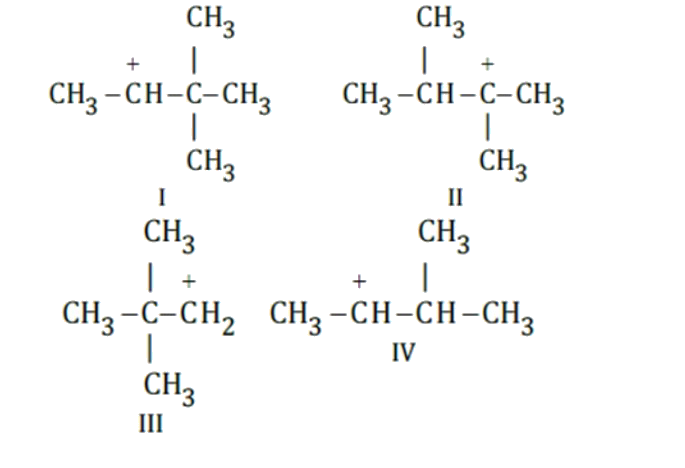Which one of the following carbanions is most stable ?
CH2=CH−−CH2


CH3−−CH−CH3
To determine which carbanion is the most stable among the given options, we will analyze each carbanion based on resonance, inductive effects, and hyperconjugation.
Step 1: Understand Carbanion Stability
Carbanions are negatively charged carbon species that have eight electrons in their valence shell. The stability of carbanions can be influenced by several factors, including:
- Resonance: Delocalization of the negative charge can stabilize the carbanion.
- Inductive Effect: Electronegative atoms or groups can withdraw electron density, affecting stability.
- Hyperconjugation: Alkyl groups can donate electron density through sigma bonds, stabilizing the carbanion.
Step 2: Analyze the First Carbanion
Let’s consider the first carbanion:
- Structure: CH2=CH-CH2^(-)
- Stability Factors:
- This carbanion can show resonance with the double bond, allowing some delocalization of the negative charge.
- However, it lacks significant inductive effects or hyperconjugation.
Step 3: Analyze the Second Carbanion
Now, let’s analyze the second carbanion:
- Structure: CH2^(-)-NO2
- Stability Factors:
- This carbanion can also show resonance with the nitro group (NO2), which is a strong electron-withdrawing group.
- The nitro group exhibits a -I (inductive) effect, which stabilizes the negative charge on carbon.
- The combination of resonance and inductive effects makes this carbanion more stable than the first.
Step 4: Analyze the Third Carbanion
Next, we look at the third carbanion:
- Structure: (CH3)2C^(-)
- Stability Factors:
- This carbanion is attached to two methyl groups, which exhibit a +I (inductive) effect.
- However, the presence of electron-donating groups can destabilize the carbanion due to increased electron density on the negatively charged carbon.
- Thus, this carbanion is less stable compared to the previous two.
Step 5: Conclusion
After analyzing all three carbanions:
1. The first carbanion has some resonance but lacks additional stabilizing effects.
2. The second carbanion benefits from both resonance and inductive effects, making it the most stable.
3. The third carbanion is destabilized by the presence of electron-donating groups.
Therefore, the most stable carbanion among the given options is the second one: CH2^(-)-NO2.
Final Answer
The most stable carbanion is the one represented by CH2^(-)-NO2.
---
Carbanions are negatively charged carbon species that have eight electrons in their valence shell. The stability of carbanions can be influenced by several factors, including:
- Resonance: Delocalization of the negative charge can stabilize the carbanion.
- Inductive Effect: Electronegative atoms or groups can withdraw electron density, affecting stability.
- Hyperconjugation: Alkyl groups can donate electron density through sigma bonds, stabilizing the carbanion.
Let’s consider the first carbanion:
- Structure: CH2=CH-CH2^(-)
- Stability Factors:
- This carbanion can show resonance with the double bond, allowing some delocalization of the negative charge.
- However, it lacks significant inductive effects or hyperconjugation.
Now, let’s analyze the second carbanion:
- Structure: CH2^(-)-NO2
- Stability Factors:
- This carbanion can also show resonance with the nitro group (NO2), which is a strong electron-withdrawing group.
- The nitro group exhibits a -I (inductive) effect, which stabilizes the negative charge on carbon.
- The combination of resonance and inductive effects makes this carbanion more stable than the first.
Next, we look at the third carbanion:
- Structure: (CH3)2C^(-)
- Stability Factors:
- This carbanion is attached to two methyl groups, which exhibit a +I (inductive) effect.
- However, the presence of electron-donating groups can destabilize the carbanion due to increased electron density on the negatively charged carbon.
- Thus, this carbanion is less stable compared to the previous two.
After analyzing all three carbanions:
1. The first carbanion has some resonance but lacks additional stabilizing effects.
2. The second carbanion benefits from both resonance and inductive effects, making it the most stable.
3. The third carbanion is destabilized by the presence of electron-donating groups.
The most stable carbanion is the one represented by CH2^(-)-NO2.
Topper's Solved these Questions
- INTRODUCTION TO ORGANIC CHEMISTRY Book:VMC MODULES ENGLISHChapter:INTRODUCTION TO ORGANIC CHEMISTRY Exercise:LEVEL 2 (Numerical value type )
Explore 15 Videos
- INTRODUCTION TO ORGANIC CHEMISTRY Book:VMC MODULES ENGLISHChapter:INTRODUCTION TO ORGANIC CHEMISTRY Exercise:JEE MAIN ARCHIVE
Explore 72 Videos
- INTRODUCTION TO ORGANIC CHEMISTRY Book:VMC MODULES ENGLISHChapter:INTRODUCTION TO ORGANIC CHEMISTRY Exercise:level 1
Explore 73 Videos
- ICONIC EQUILIBRIUMBook:VMC MODULES ENGLISHChapter:ICONIC EQUILIBRIUMExercise:IMPECCABLE
Explore 50 Videos
- IONIC EQUILIBRIUMBook:VMC MODULES ENGLISHChapter:IONIC EQUILIBRIUMExercise:IN - CHAPTER EXERCISE - K
Explore 10 Videos
Similar Questions
Knowledge Check
Which of the following carbanions is most stable?
ACH3−өCH2BCH2=CH−өCH2CCH3−O∣∣C−өCH2DCH3−NH∣∣C−өCH2Which of the following cations is most stable?
A B
B C
C D
D
Which of the following carbanion is most stable ?
View SolutionWhich of the following carbocations is most stable ?
View SolutionWhich of the following carbocations is most stable ?

View SolutionWhich one of the following carbocations are most stable?
View SolutionWhich of the following carbocation is most stable
View SolutionWhich of the following carbocation is most stable?
View Solution